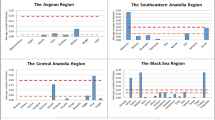Abstract
Understanding the spatial distribution patterns (SDPs) of natural disasters plays an essential role in reducing and minimizing natural disaster risks. An integrated discussion on the SDPs of multiple global disasters is still lacking. In addition, due to their high quantity and complexity, natural disasters constitute high-dimensional data that represent a challenge for an analysis of SDPs. This paper analyzed the SDPs of global disasters from 1980 to 2016 through biclustering. The results indicate that the SDPs of fatality rates are more uneven than those of occurrence rates. Based on the occurrence rates, the selected countries were clustered into four classes. (1) The major disasters along the northern Pacific and in the Caribbean Sea and Madagascar are storms, followed by floods. (2) Most of Africa is mainly affected by floods, epidemics, and droughts. (3) The primary disaster types in the Alpine-Himalayan belt and the western Andes are floods and earthquakes. (4) Europe, America, Oceania, and South and Southeast Asia are predominantly influenced by floods. In addition, according to the fatality rates, the selected countries were clustered into eight classes. (1) Extreme high temperatures mostly result in high fatality rates (HFRs) in developed countries. (2) Epidemics lead to HFRs in parts of Africa. (3) Droughts produce HFRs in East Africa. (4) Earthquakes result in HFRs along the eastern Pacific coastline and the Alpine-Himalayan belt. (5) Tsunamis mainly cause HFRs in Thailand, Indonesia, and Japan. (6) Storms result in scattered but distinct HFRs along the coastal regions of the Pacific and Indian Oceans. (7) Floods cause concentrated HFRs in South Asia and northeastern South America. (8) Finally, volcanoes cause HFRs in Colombia, while extreme low temperatures cause HFRs in Ukraine and Poland.




Similar content being viewed by others
References
Aoyama T, Shiratori N, Hagimoto K et al (2014) Lessons of the Great East Japan earthquake. IEEE Commun Mag 52:21–22
Bathrellos GD, Skilodimou HD, Chousianitis K et al (2017) Suitability estimation for urban development using multi-hazard assessment map. Sci Total Environ 575:119–134
Borden KA, Cutter SL (2008) Spatial patterns of natural hazards mortality in the United States. Int J Health Geogr 7:64
Cheng Y, Church GM (2000) Biclustering of expression data. Intell Syst Mol Biol 8:93
Council NR (2012) Disaster resilience: a national imperative. The National Academies Press, Washington, DC
Cvetkovic V (2013) Spatial and temporal distribution of geophysical disasters. J Geogr Inst Jovan Cvijic SASA 63:345–360
Dilley M (2006) Setting priorities: global patterns of disaster risk. Philos Trans R Soc A 364:2217–2229
Ferraty F (2010) High-dimensional data: a fascinating statistical challenge. J Multivar Anal 101:305–306
Guha-Sapir D EM-DAT: the CRED/OFDA international disaster database. http://www.emdat.be/
Han W, Liang C, Jiang B et al (2016) Major natural disasters in China, 1985–2014: occurrence and damages. Int J Environ Res Public Health 13:1118
Izenman AJ, Harris PW, Mennis J et al (2011) Local spatial biclustering and prediction of urban juvenile delinquency and recidivism. Stat Anal Data Min 4:259–275
Knapp KR, Kruk MC, Levinson DH et al (2010) The international best track archive for climate stewardship (IBTrACS). Bull Am Meteorol Soc 91:363–376
Li C, Chai Y, Yang L, Li H (2016) Spatio-temporal distribution of flood disasters and analysis of influencing factors in Africa. Nat Hazards 82:721–731
Madeira SC, Oliveira AL (2004) Biclustering algorithms for biological data analysis: a survey. IEEE/ACM Trans Comput Biol Bioinform 1:24–45
Masih I, Maskey S, Mussá FEF, Trambauer P (2014) A review of droughts on the African continent: a geospatial and long-term perspective. Hydrol Earth Syst Sci 18:3635–3649
McCall C (2017) Remembering the Indian Ocean tsunami. Lancet 384:2095–2098
Oh CH, Oetzel J (2011) Multinationals’ response to major disasters: how does subsidiary investment vary in response to the type of disaster and the quality of country governance? Strateg Manag J 32:658–681
Padilha VA, Campello RJGB (2017) A systematic comparative evaluation of biclustering techniques. BMC Bioinform 18:55
Peng Y, Song J, Cui T, Cheng X (2017) Temporal-spatial variability of atmospheric and hydrological natural disasters during recent 500 years in Inner Mongolia, China. Nat Hazards 89:441–456
Pontes B, Giráldez R, Aguilar-Ruiz JS (2015) Biclustering on expression data: a review. J Biomed Inform 57:163–180
Sasa M, Cvetkovic VM (2014) Victimization of people by natural disasters: spatial and temporal distribution of consequences. Temida 17:19–42
Shen S, Cheng C, Su K et al (2016) Quantitative visualization about differences between scientists concerned nature disasters and historic events. In: 2016 International conference on behavioral, economic and socio-cultural computing (BESC), pp 1–6
Shi P (1996) Theory and practice of disaster study. J Nat Disasters 11:6–17
Shi P (2002) Theory on disaster science and disaster dynamics. J Nat Disasters 11:1–9
Shi P, Li N, Ye Q et al (2010) Research on integrated disaster risk governance in the context of global environmental change. Int J Disaster Risk Sci 1:17–23
Stone R, Kerr RA (2005) Girding for the next killer wave. Science 310:1602–1605
Tappin DR, Watts P, Grilli ST (2008) The Papua New Guinea tsunami of 17 July 1998: anatomy of a catastrophic event. Nat Hazards Earth Syst Sci 8:243–266
Tweed F, Walker G (2011) Some lessons for resilience from the 2011 multi-disaster in Japan. Local Environ 16:937–942
Yang T, Wang X, Zhao C et al (2011) Changes of climate extremes in a typical arid zone: observations and multimodel ensemble projections. J Geophys Res Atmos. https://doi.org/10.1029/2010JD015192
Zhao Y, Karypis G (2003) Clustering in life sciences. In: Brownstein MJ, Khodursky AB (eds) Functional genomics: methods and protocols. Humana Press, Totowa, pp 183–218
Acknowledgements
We would like to thank the anonymous reviewers for their constructive comments on the manuscript. This work was supported by National Natural Science Foundation of China [Grant Number 41771537], National Key Research and Development Plan of China [Grant Number 2017YFB0504102], and the Fundamental Research Funds for the Central Universities.
Author information
Authors and Affiliations
Corresponding author
Rights and permissions
About this article
Cite this article
Shen, S., Cheng, C., Song, C. et al. Spatial distribution patterns of global natural disasters based on biclustering. Nat Hazards 92, 1809–1820 (2018). https://doi.org/10.1007/s11069-018-3279-y
Received:
Accepted:
Published:
Issue Date:
DOI: https://doi.org/10.1007/s11069-018-3279-y




